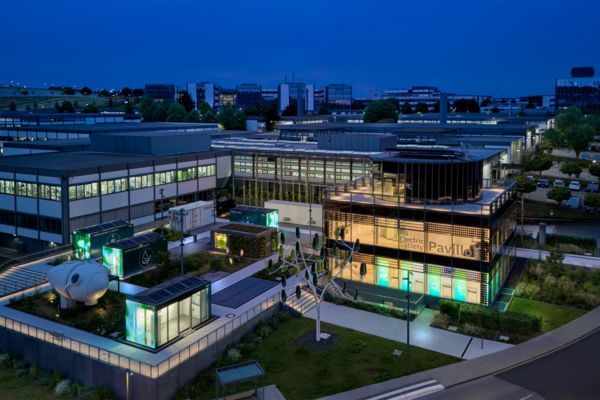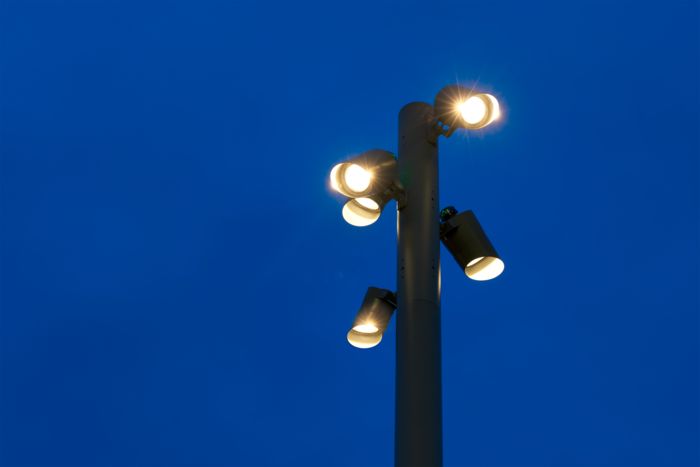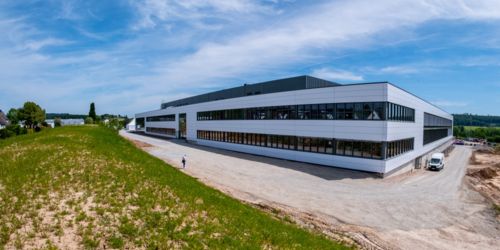Networked lighting solutions in the All Electric Society Park Spot on for more efficiency, quality, and sustainability.

Brief summary
The implementation of smart lighting systems in the All Electric Society Park impressively demonstrates how state-of-the-art technology can help industrial companies overcome the challenges they face. They offer a digital communication infrastructure that supports companies as they strive for greater sustainability and cost-effectiveness through digitalization and effectively promotes sector coupling.

The special lampposts ensure needs-based, functional lighting throughout the entire park area. The sensor is integrated discreetly in the lower floodlight element
Spot on for intelligent lighting solutions
Just like cities and municipalities, industrial companies are under constant pressure to reduce operating costs, increase efficiency, and at the same time meet high safety and environmental standards.
Providing lighting for the facilities is a piece of this puzzle. The All Electric Society Park from Phoenix Contact in Blomberg shows how to solve this puzzle with customized and future-proof solutions.

The entire lighting in the pavilion is also attached to the central light control system. This ensures that the right light is available at the right time and in the right place in the All Electric Society Park at all times
Smart lighting: efficient and sustainable
How can this be done efficiently and sustainably? The answer lies in implementing smart lighting systems that feature much more than just light.
In Phoenix Contact’s All Electric Society Park in Blomberg, the lighting system is an integral part of the park’s entire energy management system. At the same time, it provides the necessary communication infrastructure for the various devices, actuators, sensors, energy consumers, and generators of this network.

Each post is connected to the overall system wirelessly via LoRaWAN and integrated into the data network
More light, more safety
The park is freely accessible and open around the clock. This is why it is necessary to make it safe, attractive, and open to visitors even at dusk and after dark. The overall lighting concept is inviting, harmonious, and creates a pleasant atmosphere. This makes the park, which is already attractive in terms of design and technology, a showpiece for the company at night as well.
The lampposts in the All Electric Society Park are true multi-talents. The LED lighting and sensors for detecting motion and the light level are located in the upper area. Below them are loudspeakers and special LED systems for colored light to create atmospheric lighting.

The carports in the charging park are also illuminated. These are also important elements for the general safety and user comfort in the park
The total power of the lighting in the All Electric Society Park is approx. 7.8 kW. The LED street lights that are used for this, for instance, have a maximum power consumption of 36 watts and a light output of around 91 lumens per watt. They can be dimmed to any level and with no delay.
This means that the level of lighting in the All Electric Society Park can be adapted according to demand and visitor frequency. After all, the park is equipped with a number of sensors and actuators, including motion sensors, which are connected to the lighting system. When there are no visitors in the park, the level of lighting is dimmed down to approximately 40% of the regulatory specifications. When motion is detected, the system ramps up to full power. This fulfills the specifications and ensures the greatest possible safety on the paths.
This makes it possible to meet regulatory requirements and achieve additional savings at the same time. Compared to conventional lighting, this version of efficient LED technology is linked to intelligent and needs-based control management, making it approximately 80% more efficient and therefore more sustainable.
Smart communication solution as the basis
The prerequisite for this is a smart communication solution that connects the lighting system to the entire park. This solution features coordinated hardware, tailored service, an IoT platform with high performance and an open architecture, and intuitive software.
Together, these blocks form a flexible and efficient system that improves the quality of the lighting, reduces operating costs, and optimizes energy consumption. The park’s control system is linked to the grovez.io IoT platform, which manages the control of the street lighting.

The handrails along the stairs in the park are also illuminated. These are also important elements for the general safety and user comfort in the park
How the system works
The hardware consists of LoRaWAN-capable Luminaire Controller Units (LCU) and Segment Controller Units (SCU). LoRaWAN enables a long range with low energy consumption combined with a high level of transmission reliability based on end-to-end encryption and is therefore ideal for use in large outdoor areas. The controllers establish the connection from the individual lights or light groups to a gateway. These gateways serve as the interface for communication and data transmission between the control units and other systems for property management.
The IoT platform is the heart of the system. All the information from the environmental sensors, weather detectors, and operating states of the participating systems are collected here. The data from the park is recorded in one central location and linked together.
With its clearly arranged dashboard, the software makes it possible to have full control of the system at any time and from any location. Functions include real-time monitoring, energy analysis, planning and automation of lighting scenarios, and an alarm system in the event of irregularities or system failures.
The implementation of smart lighting systems in the All Electric Society Park impressively demonstrates how state-of-the-art technology can help industrial companies overcome the challenges they face. Using energy-efficient LED lights and an intelligent, needs-based control system not only significantly reduces energy consumption – it also reduces operating costs and improves safety. The operating costs are also reduced and safety is improved.
Overall, this example shows that smart lighting offers much more than just light: It can provide a digital communication infrastructure that can also benefit companies as they strive for greater sustainability and cost-effectiveness through digitalization.
Summary
The implementation of smart lighting systems in the All Electric Society Park impressively demonstrates how state-of-the-art technology can help industrial companies overcome the challenges they face. They offer a digital communication infrastructure that supports companies as they strive for greater sustainability and cost-effectiveness through digitalization and effectively promotes sector coupling.
Connect with our experts





